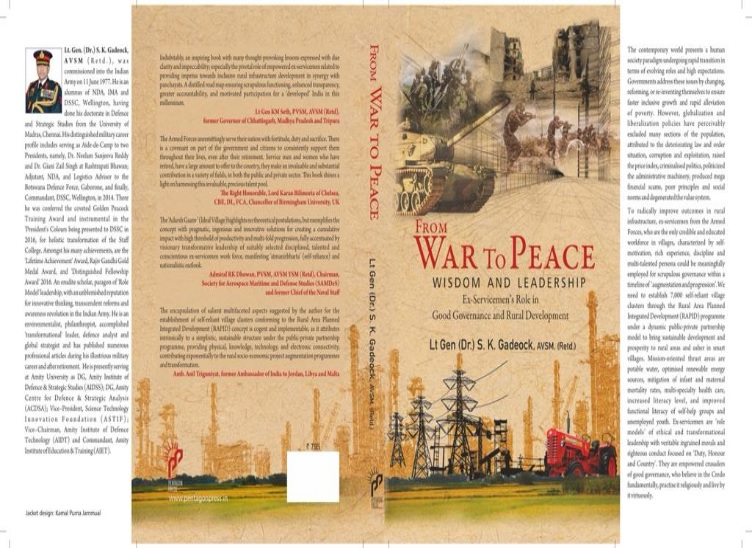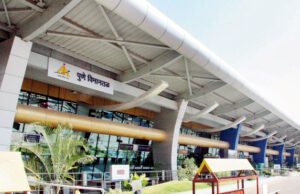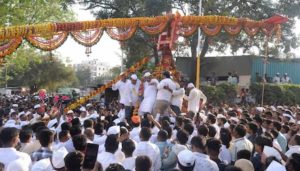Book Review War To Peace: Resettlement Of Ex-Servicemen In Rural Development Is Imperative For Nation Building

By Maj Gen Jagatbir Singh, VSM (retd)
New Delhi, 30th April 2023: Lieutenant General SK Gadeock, who retired as the Commandant of the Defence Service Staff College after a distinguished military career, has written “From War to Peace.” In his book, he examines the role of ex-servicemen in good governance and rural development.
The issues that he has touched upon are both relevant and contemporary. He has examined them in an extremely detailed manner, providing various statistics to support his argument. He then suggests ideas for their implementation, which the NSA, in a letter to the author, has called “novel and incisive.”
While a military career is balanced, respectable, and extremely satisfying, what comes to everyone’s mind inevitably toward the end of their career is, “what’s next?” Approximately 60,000 personnel retire every year, of which 44 percent are in the age group of 40-50, and 33 percent in the age group of 35-40 years. With the Agniveers, these figures will change, and there will be personnel retiring at even younger ages. These personnel will retire without a pension but will have received some financial benefits to help them transition to their second career. The focus of the author is on the optimum utilization of this motivated, disciplined, and skilled workforce towards nation-building.
In the first of five chapters, namely “Good Governance and Rural Development; A Conceptual Framework,” the author writes about the fundamentally unbalanced relationship between urban and rural areas. He then gives recommendations on measures to be taken to reduce this divide, which includes better targeting of investments to meet economic and poverty alleviation goals. He states that while rural-to-urban migration has aided in the eradication of poverty, formal and informal policy barriers still restrict the movement of the population, which need to be eliminated.
There needs to be the development of a non-rural farm sector, for which public investment in infrastructure, health, and education is crucial. The focus must also be on developing small rural towns to serve as transitional areas between rural and urban areas. He then lists his vision and gives a two-pronged approach strategy for its realization, which includes accelerating income and employment growth, and eliminating the deprivation of basic facilities, which includes sanitation and water, and designing delivery mechanisms to provide these.
In the second chapter, “Odyssey of Socio-Economic Growth in India,” Lieutenant General Gadeock covers an extremely wide canvas. He clearly states that tepid land reforms, coupled with state interventions in food pricing and procurement, have served only to retard the larger transformation of agriculture, which is the primary sector of the Indian economy. Today, due to the rapid pace of urbanization, rural life is also being transformed, and he writes that the first priority for societal transformation is accelerated rural development. Basically, implying that while urbanization is taking place by leaps and bounds, rural development is suffering. He states that “agriculture is no longer the unique centre of economic life in rural India. The advance of capitalism and the emergence of industrial and service industries have provided different forms of livelihood creating a rural non-farm path to growth.” He has, of course, backed all his arguments with lots of data and statistics.
Chapter three deals with “Success Stories of Rural Development in India.” He feels the 21st Century model village needs to incorporate certain key themes which are: Sustainability, Community Involvement, Technology and Connectivity, and thereafter lists out what constitutes these themes. The two ‘success states’ are Gujarat and Tamil Nadu.
As for Gujarat, the author writes about the Jyoti Gram Yojna, which has ensured the availability of 24-hour, three-phase quality power supply to rural areas. Gujarat has transformed from a power-deficient to a power-surplus state. The state-wide “Drinking Water Grid” and “Agricultural Initiatives,” including “micro water harvesting,” have resulted in using less water to produce the same results. The “Krishi Mahotsav” started in 2005, educating farmers by visiting every village yearly, and the “Garib Kalyan Mela” is a program for social transformation that combines the benefits of many programs, eliminating intermediaries and reaching the most vulnerable. One of the good governance practices is the “Samas Yojna Programme,” which gives a village Rupees One Lac if they elect their representative unanimously. Today, the rapid growth of Gujarat, as compared to other states, is largely due to its significantly higher comparative advantage in agriculture and manufacturing.
Tamil Nadu is another story of growth-oriented development. Higher growth means higher employment. The factors that contributed to Tamil Nadu’s growth are its industrial growth, where the share of manufacturing is 17% of the Gross State Domestic Product. In agriculture, it has implemented a multitude of crop-oriented schemes for the welfare of the farming community. Energy security is another area of focus, and while it is still deficient in energy, it has invested a lot in renewable energy sources, including 7,178 MW of wind power.
The author also mentions schemes like budget canteens, education to include infrastructure works undertaken in schools, and the provision of free education. Under Skill Development, the State government has forged partnerships with industry to identify skill gaps and design courses leading to “Modular Employable Skill Certification.” The Village Habitations Improvement Scheme has been covered in great detail. Apart from this, the author has also explained the Provision of Urban Amenities in Rural Areas (PURA) in meticulous detail. He also mentions the “Tamil Nadu Vision Document 2023,” which was curated by Ms Jayalalitha with the aim of putting Tamil Nadu among the top Indian states in development, emphasizing that “all should get everything, and there should not be a condition of have not.”
Chapter Four, “Ex-Serviceman’s Leadership: A Paragon for Rural Development,” is the heart of the book. General Gadeock has examined “Societal Structure & Administrative Setup” (SOSAS) under the Ashoka period, during the Chola dynasty, and under the Mughals in great detail. He then states that while the leaders in the Armed Forces are a true epitome of transformational leadership, the “irony is that these men in uniform are not being co-opted in nation-building and holistic growth once they superannuate.”
He then gives out a strategy to ensure the development of rural areas, “Rural Area Progressive Integrated Development (RAPID),” unfortunately, “Ex-Servicemen (ESM) remain a resource untapped.” He states that “the bureaucratic imprint of ineptitude has been strongly revealed at the village level,” and “the local-level politician is steeped in old age petty parochialism and greed.” Or as stated in the “Introduction,” “no single institution has come to disappoint Indians more than their bureaucracy.”
This is one of the reasons why the fruits of development have not reached all evenly. The men and women in “olive,” “whites,” and “blue” could be put to great use in civil life. With their inherent discipline and training, they can contribute across multiple dimensions. ESMs undoubtedly possess a bouquet of qualities, but what stands out is their commitment and ability to deliver.
As a result, rapid economic and social transformation at the village level can be achieved with their expertise; hence optimization of their skills is a necessity. However, their empowerment needs legislative backing.
Thereafter, the book covers details of the schemes of Directorate General of Resettlement, the retiring details of ESMs to include their skill sets, pan India distribution of ESMs, and types of employment available backed by statistics in Gazetted and Non-Gazetted jobs. He once again highlights the young age at which ESMs retire and states, “ensuring full employment of its people till they attain the age of 60 has now become one of the major welfare objectives of all states”.
He writes that 80% of ESM JCOs and NCOs are settled in villages. “Investments incurred in their specialized training and training acquired in the Army, both technical and moral, should not go to waste”. He then lists out where they can be utilized and the support that requires to be given. The other area he has covered is giving tax concessions to private industries that employ ESMs.
However, while his recommendations are exhaustive, the crux lies in the recommendations for employment being backed by suitable legislation by Parliament. Having dealt with this subject while in service, one of the best ways to ensure the implementation of various measures is by having an empowered Ex-Servicemen’s Commission. The dream of creating a smart/ideal village can become a reality if the ESMs are suitably engaged.
The last chapter focuses on “A Citizens-First Approach: Insights into Good Governance”. The author elucidated comprehensive critical issues which, if implemented and concluded in the correct perspective, would enhance “good governance” in the country. He then covers a range of issues from national security, containing the threat of Left-Wing insurgency, judicial reforms, empowerment to include self-empowerment, mutual empowerment, and social empowerment. The other issues examined include “generation of employment,” “delivery of services in social sector, urban planning capacity building for the nation, and infrastructure development” amongst others.
He concludes by stating that ESMs “are ‘role models’ of ethical leadership and an ingrained value system contributing to society and nation-building with a great sense of commitment towards multifaceted progression and excellence in all spheres of activities”. “Governance Augmentation and Progression” can be brought about at the grassroots level by ESMs residing in villages, given their commitment and ability to monitor the execution of developmental projects.
It goes without saying that to improve outcomes in rural governance, the talent of ESMs from the Armed Forces who are still in their prime and possess the requisite qualities and skill sets across a wide spectrum of job descriptions must be meaningfully utilized. These ESMs belong to all parts of India, though there are areas where their concentration is greater. A good model that can be built upon is the “Guardians of Governance,” which was introduced in Punjab by Amarinder Singh when he was the Chief Minister.
The book is undoubtedly an important contribution to the existing literature on good governance and national development. The author has touched upon a raw nerve as far as the employment of ESM, a trained national resource in the prime of their years, is concerned and has given very meaningful suggestions. There is no doubt that veterans can play a valuable and vital role in nation-building. It is hence imperative that the contribution of ESMs who retire at a comparatively young age when most of them have unfulfilled commitments to their families with regard to the education and marriage of their children must be harnessed for the socio-economic development of the country. The challenge lies in getting the legislature to empower them to take on the roles identified by the author in contributing to nation-building.








